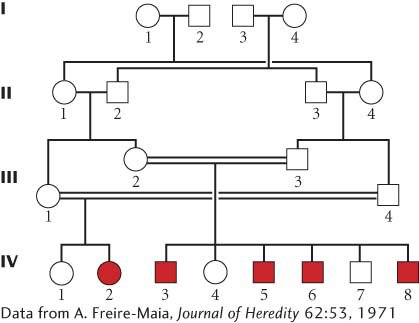APPLICATION QUESTIONS AND PROBLEMS
Introduction
Question 13
13.The inheritance of red hair was discussed in the introduction to this chapter. At times in the past, red hair in humans was thought to be a recessive trait, and at other times, it was thought to be a dominant trait. What features of inheritance would red hair be expected to exhibit as a recessive trait? What features would it be expected to exhibit if it were a dominant trait?
Section 3.1
Question 14
14.What characteristics of an organism would make it suitable for studies of the principles of inheritance? Can you name several organisms that have these characteristics?
Section 3.2
Question 15
15.In cucumbers, orange fruit color (R) is dominant over cream fruit color (r). A cucumber plant homozygous for orange fruit is crossed with a plant homozygous for cream fruit. The F1 are intercrossed (F1 individuals crossed with F1 individuals) to produce the F2.
Give the genotypes and phenotypes of the parents, the F1, and the F2.
Give the genotypes and phenotypes of the offspring of a backcross between the F1 and the orange-
fruited parent. Give the genotypes and phenotypes of a backcross between the F1 and the cream-
fruited parent.
70
Question 16
16.Figure 1.1 shows three girls, one of whom has albinism. Could the three girls shown in the photograph be sisters? Why or why not?
Question 17
17. J. W. McKay crossed a stock melon plant that produced tan seeds with a plant that produced red seeds and obtained the following results (J. W. McKay. 1936. Journal of Heredity 27:110–112).
J. W. McKay crossed a stock melon plant that produced tan seeds with a plant that produced red seeds and obtained the following results (J. W. McKay. 1936. Journal of Heredity 27:110–112).
| Cross | F1 | F2 |
|---|---|---|
tan  × red × red  |
13 tan seeds | 93 tan, 24 red seeds |
Explain the inheritance of tan seeds and red seeds in this plant.
Assign symbols for the alleles in this cross and give genotypes for all the individual plants.
Question 18
*18. White (w) coat color in guinea pigs is recessive to black (W). In 1909, W. E. Castle and J. C. Phillips transplanted an ovary from a black guinea pig into a white female whose ovaries had been removed. They then mated this white female with a white male. All the offspring from the mating were black (W. E. Castle and J. C. Phillips. 1909. Science 30:312–313).
White (w) coat color in guinea pigs is recessive to black (W). In 1909, W. E. Castle and J. C. Phillips transplanted an ovary from a black guinea pig into a white female whose ovaries had been removed. They then mated this white female with a white male. All the offspring from the mating were black (W. E. Castle and J. C. Phillips. 1909. Science 30:312–313).
Explain the results of this cross.
Give the genotype of the offspring of this cross.
What, if anything, does this experiment indicate about the validity of the pangenesis and the germ-
plasm theories discussed in Chapter 1?
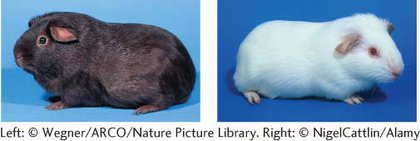
Question 19
19.In cats, blood type A results from an allele IA, which is dominant over an allele iB that produces blood type B. (There is no O blood type, as there is in humans.) The blood types of male and female cats that were mated and the blood types of their kittens are presented in the following table. Give the most likely genotypes for the parents of each litter.
| Male parent | Female parent | Kittens | |
|---|---|---|---|
| a. | A | B | 4 kittens with type A, 3 kittens with type B |
| b. | B | B | 6 kittens with type B |
| c. | B | A | 8 kittens with type A |
| d | A | A | 7 kittens with type A, 2 kittens with type B |
| e. | A | A | 10 kittens with type A |
| f. | A | B | 4 kittens with type A, 1 kitten with type B |
Question 20
20.Figure 3.6 shows the results of a cross between a tall pea plant and a short pea plant.
What phenotypes will be produced, and in what proportions, if a tall F1 plant is backcrossed to the short parent?
What phenotypes will be produced, and in what proportions, if a tall F1 plant is backcrossed to the tall parent?
Question 21
21.Joe has a white cat named Sam. When Joe crosses Sam with a black cat, he obtains ½ white kittens and ½ black kittens. When the black kittens are interbred, all the kittens that they produce are black. On the basis of these results, which coat color (white or black) in cats would you conclude is a recessive trait? Explain your reasoning.
Question 22
*22.Alkaptonuria is a metabolic disorder in which affected persons produce black urine. Alkaptonuria results from an allele (a) that is recessive to the allele for normal metabolism (A). Sally has normal metabolism, but her brother has alkaptonuria. Sally’s father has alkaptonuria, and her mother has normal metabolism.
Give the genotypes of Sally, her mother, her father, and her brother.
If Sally’s parents have another child, what is the probability that this child will have alkaptonuria?
If Sally marries a man with alkaptonuria, what is the probability that their first child will have alkaptonuria?
Question 23
23.Hairlessness in American rat terriers is recessive to the presence of hair. Suppose that you have a rat terrier with hair. How can you determine whether this dog is homozygous or heterozygous for the hairy trait?
Question 24
*24.What is the probability of rolling one six-
2
1 or 2
An even number
Any number but a 6
Question 25
*25.What is the probability of rolling two six-
2 and 3
6 and 6
At least one 6
Two of the same number (two 1s, or two 2s, or two 3s, etc.)
An even number on both dice
An even number on at least one die
Question 26
26.Phenylketonuria (PKU) is a disease that results from a recessive gene. Two normal parents produce a child with PKU.
71
What is the probability that a sperm from the father will contain the PKU allele?
What is the probability that an egg from the mother will contain the PKU allele?
What is the probability that their next child will have PKU?
What is the probability that their next child will be heterozygous for the PKU gene?
Question 27
*27.In German cockroaches, a curved wing (cv) is recessive to a normal wing (cv+). A homozygous cockroach that has normal wings is crossed with a homozygous cockroach that has curved wings. The F1 are intercrossed to produce the F2. Assume that the pair of chromosomes containing the locus for wing shape is metacentric. Draw this pair of chromosomes as it would appear in the parents, the F1, and each class of F2 progeny at metaphase I of meiosis. Assume that no crossing over takes place. At each stage, label a location for the alleles for wing shape (cv and cv+) on the chromosomes.
Question 28
*28.In guinea pigs, the allele for black fur (B) is dominant over the allele for brown fur (b). A black guinea pig is crossed with a brown guinea pig, producing five F1 black guinea pigs and six F1 brown guinea pigs.
How many copies of the black allele (B) will be present in each cell of an F1 black guinea pig at the following stages: G1, G2, metaphase of mitosis, metaphase I of meiosis, metaphase II of meiosis, and after the second cytokinesis following meiosis? Assume that no crossing over takes place.
How many copies of the brown allele (b) will be present in each cell of an F1 brown guinea pig at the same stages as those listed in part a? Assume that no crossing over takes place.
Section 3.3
Question 29
29.In watermelons, bitter fruit (B) is dominant over sweet fruit (b), and yellow spots (S) are dominant over no spots (s). The genes for these two characteristics assort independently. A homozygous plant that has bitter fruit and yellow spots is crossed with a homozygous plant that has sweet fruit and no spots. The F1 are intercrossed to produce the F2.
What are the phenotypic ratios in the F2?
If an F1 plant is backcrossed with the bitter, yellow-
spotted parent, what phenotypes and proportions are expected in the offspring? If an F1 plant is backcrossed with the sweet, non-
spotted parent, what phenotypes and proportions are expected in the offspring?
Question 30
30.Figure 3.8 shows the results of a dihybrid cross involving seed shape and seed color.
What proportion of the round and yellow F2 progeny from this cross is homozygous at both loci?
What proportion of the round and yellow F2 progeny from this cross is homozygous at least at one locus?
Question 31
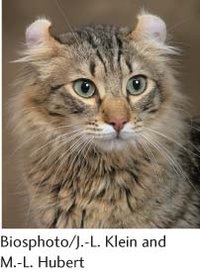
*31.In cats, curled ears result from an allele (Cu) that is dominant over an allele for normal ears (cu). Black color results from an independently assorting allele (G) that is dominant over an allele for gray (g). A gray cat homozygous for curled ears is mated with a homozygous black cat with normal ears. All the F1 cats are black and have curled ears.
If two of the F1 cats mate, what phenotypes and proportions are expected in the F2?
An F1 cat mates with a stray cat that is gray and possesses normal ears. What phenotypes and proportions of progeny are expected from this cross?
Question 32
*32.The following two genotypes are crossed: Aa Bb Cc dd Ee × Aa bb Cc Dd Ee. What will the proportion of the following genotypes be among the progeny of this cross?
Aa Bb Cc Dd Ee
Aa bb Cc dd ee
aa bb cc dd ee
AA BB CC DD EE
Question 33
33.In cucumbers, dull fruit (D) is dominant over glossy fruit (d), orange fruit (R) is dominant over cream fruit (r), and bitter cotyledons (B) are dominant over non-
Give the phenotypes and their expected proportions in the F2.
An F1 plant is crossed with a plant that has glossy, cream fruit and non-
bitter cotyledons. Give the phenotypes and expected proportions among the progeny of this cross.
Question 34
*34.Alleles A and a are located on a pair of metacentric chromosomes. Alleles B and b are located on a pair of acrocentric chromosomes. A cross is made between individuals having the following genotypes: Aa Bb × aa bb.
Draw the chromosomes as they would appear in each type of gamete produced by the individuals of this cross.
For each type of progeny resulting from this cross, draw the chromosomes as they would appear in a cell at G1, G2, and metaphase of mitosis.
72
Section 3.4
Question 35
*35. J. A. Moore investigated the inheritance of spotting patterns in leopard frogs (J. A. Moore. 1943. Journal of Heredity 34:3–7). The pipiens phenotype has the normal spots that give leopard frogs their name. In contrast, the burnsi phenotype lacks spots on its back. Moore carried out the following crosses, producing the progeny indicated.
J. A. Moore investigated the inheritance of spotting patterns in leopard frogs (J. A. Moore. 1943. Journal of Heredity 34:3–7). The pipiens phenotype has the normal spots that give leopard frogs their name. In contrast, the burnsi phenotype lacks spots on its back. Moore carried out the following crosses, producing the progeny indicated.
| Parent phenotypes | Progeny phenotypes |
|---|---|
| burnsi × burnsi | 39 burnsi, 6 pipiens |
| burnsi × pipiens | 23 burnsi, 33 pipiens |
| burnsi × pipiens | 196 burnsi, 210 pipiens |
On the basis of these results, what is the most likely mode of inheritance of the burnsi phenotype?
Give the most likely genotypes of the parent in each cross (use B for the burnsi allele and B+ for the pipiens allele).
Use a chi-
square test to evaluate the fit of the observed numbers of progeny to the number expected on the basis of your proposed genotypes.
Question 36
*36.In the California poppy, an allele for yellow flowers (C) is dominant over an allele for white flowers (c). At an independently assorting locus, an allele for entire petals (F) is dominant over an allele for fringed petals (f). A plant that is homozygous for yellow and entire petals is crossed with a plant that is white and fringed. A resulting F1 plant is then crossed with a plant that is white and fringed, and the following progeny are produced: 54 yellow and entire, 58 yellow and fringed, 53 white and entire, and 10 white and fringed.
Use a chi-
square test to compare the observed numbers with those expected for the cross. What conclusion can you make from the results of the chi-
square test? Suggest an explanation for the results.
Section 3.5
Question 37
37. Many studies have suggested a strong genetic predisposition to migraine headaches, but the mode of inheritance is not clear. L. Russo and colleagues examined migraine headaches in several families, two of which are shown in the following pedigree (L. Russo et al. 2005. American Journal of Human Genetics 76:327–333). What is the most likely mode of inheritance for migraine headaches in these families? Explain your reasoning.
Many studies have suggested a strong genetic predisposition to migraine headaches, but the mode of inheritance is not clear. L. Russo and colleagues examined migraine headaches in several families, two of which are shown in the following pedigree (L. Russo et al. 2005. American Journal of Human Genetics 76:327–333). What is the most likely mode of inheritance for migraine headaches in these families? Explain your reasoning.
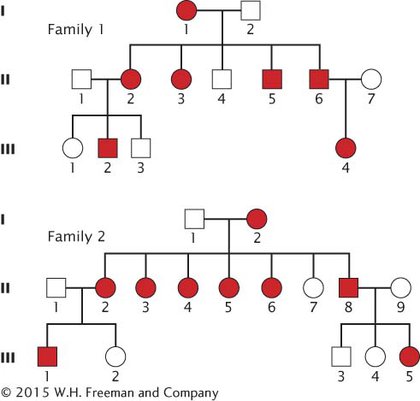
Question 38
38.For each of the following pedigrees, give the most likely mode of inheritance, assuming that the trait is rare. Carefully explain your reasoning.
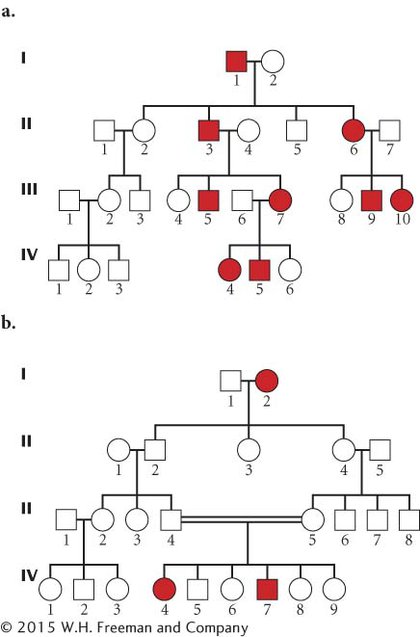
73
Question 39
39. Ectrodactyly is a rare condition in which the fingers are absent and the hand is split. This condition is usually inherited as an autosomal dominant trait. Ademar Freire-
Ectrodactyly is a rare condition in which the fingers are absent and the hand is split. This condition is usually inherited as an autosomal dominant trait. Ademar Freire-
